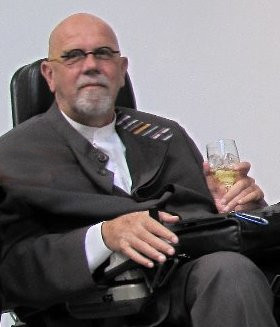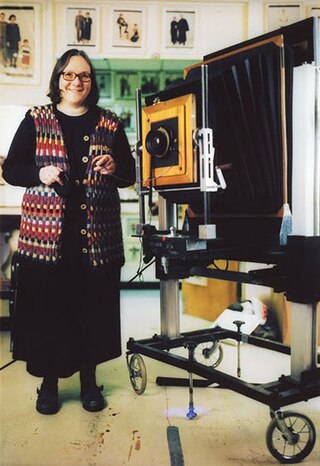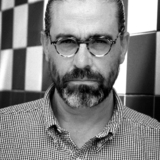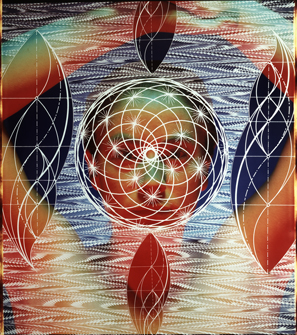
Louis Mendes (born June 15, 1940) is a photographer from New York City who is known for his signature press camera, portraits and street portraits. [1] [2] [3] [4] [5]

Louis Mendes (born June 15, 1940) is a photographer from New York City who is known for his signature press camera, portraits and street portraits. [1] [2] [3] [4] [5]
Mendes was born in a working-class family in Jamaica, Queens, New York, in 1940. He was a young child when his elder sister handed him a camera to begin documenting family events. Later Mendes would study at the RCA Institute of Technology. After stints of working in retail including Macy's on 34th street, Mendes turned to photography.[ citation needed ]
Mendes predominantly uses a Graflex Speed Graphic camera; he has also used a Polaroid Spectra, modified Polaroid 110b, view camera and medium and large format cameras.[ citation needed ]

A press camera is a medium or large format view camera that was predominantly used by press photographers in the early to mid-20th century. It was largely replaced for press photography by 35mm film cameras in the 1960s, and subsequently, by digital cameras. The quintessential press camera was the Speed Graphic. Press cameras are still used as portable and rugged view cameras.

Edwin Herbert Land, ForMemRS, FRPS, Hon.MRI was an American scientist and inventor, best known as the co-founder of the Polaroid Corporation. He invented inexpensive filters for polarizing light, a practical system of in-camera instant photography, and the retinex theory of color vision, among other things. His Polaroid instant camera went on sale in late 1948 and made it possible for a picture to be taken and developed in 60 seconds or less.

An instant camera is a camera which uses self-developing film to create a chemically developed print shortly after taking the picture. Polaroid Corporation pioneered consumer-friendly instant cameras and film, and were followed by various other manufacturers.
Bill Brandt was a British photographer and photojournalist. Born in Germany, Brandt moved to England, where he became known for his images of British society for such magazines as Lilliput and Picture Post; later he made distorted nudes, portraits of famous artists and landscapes. He is widely considered to be one of the most important British photographers of the 20th century.

Graflex was a manufacturer that gave its brand name to several camera models.

Charles Thomas Close was an American painter, visual artist, and photographer who made massive-scale photorealist and abstract portraits of himself and others. Close also created photo portraits using a very large format camera. He adapted his painting style and working methods in 1988, after being paralyzed by an occlusion of the anterior spinal artery.

Instant film is a type of photographic film that was introduced by Polaroid Corporation to produce a visible image within minutes or seconds of the photograph's exposure. The film contains the chemicals needed for developing and fixing the photograph, and the camera exposes and initiates the developing process after a photo has been taken.

Elsa B. Dorfman was an American portrait photographer. She worked in Cambridge, Massachusetts, and was known for her use of a large-format instant Polaroid camera.

The SX-70 is a folding single lens reflex Land camera which was produced by the Polaroid Corporation from 1972 to 1981. The SX-70 helped popularize instant photography.
Polaroid Type 55 film is a black-and-white peel-apart Polaroid film that yields both a positive print and a negative image that can be used to create enlargements.

David Burnett is an American magazine photojournalist based in Washington, D.C. His work from the 1979 Iranian revolution was published extensively in Time.
Taiji Arita was a Japanese commercial photographer who exhibited non-commercial nudes and other work, and later a painter and sculptor.

Arthur (Usher) Fellig, known by his pseudonym Weegee, was a photographer and photojournalist, known for his stark black and white street photography in New York City.
Marie Cosindas was an American photographer. She was best known for her evocative still lifes and color portraits. Her use of color photography in her work distinguished her from other photographers in the 1960s and 1970s. Most of her photographs were portraits and pictures of objects like dolls, flowers, and masks.

Derek Ridgers is a British photographer known for his photography of music, film and club/street culture. He has photographed people including James Brown, the Spice Girls, Clint Eastwood and Johnny Depp, as well as politicians, gangsters, artists, writers, fashion designers and sports people. Ridgers has also photographed British social scenes such as skinhead, fetish, club, punk and New Romantic.
Maciej Dakowicz is a Polish street photographer, photojournalist and gallerist. He is from Białystok in North East Poland. Dakowicz is best known for his series of photographs of Cardiff night-life titled Cardiff after Dark. He and others set up and ran Third Floor Gallery in Cardiff and he was a member of the In-Public street photography collective.

The Polaroid 20×24 camera is a very large instant camera made by Polaroid, with film plates that measure a nominal 20 by 24 inches, giving the camera its name, although at least one camera takes pictures that are 23 by 36 inches.

José Ortiz-Echagüe was a Spanish entrepreneur, industrial and military engineer, pilot and photographer, founder of Construcciones Aeronáuticas SA (CASA) and Honorary lifetime President of SEAT. He was also nominated Gentilhombre de cámara con ejercicio during the reign of the King of Spain Alfonso XIII.

Ellen Carey is an American artist known for conceptual photography exploring non-traditional approaches involving process, exposure, and paper. Her work has ranged from painted and multiple-exposure, Polaroid 20 x 24, Neo-Geo self-portraits beginning in the late 1970s to cameraless, abstract photograms and minimal Polaroid images from the 1990s onward, which critics often compare to color-field painting. Carey's sixty one-person exhibitions have been presented at museums, such as the Amon Carter Museum of American Art, International Center of Photography (ICP) and Wadsworth Atheneum Museum of Art, alternative spaces such as Hallwalls and Real Art Ways, and many commercial galleries. Her work is in numerous museum collections, including those of the Metropolitan Museum of Art, Whitney Museum of American Art, Los Angeles County Museum of Art, Centre Pompidou, and Smithsonian American Art Museum. In 2019, she was named one of the Royal Photographic Society (London) "Hundred Heroines", recognizing leading women photographers worldwide. Los Angeles Times critic Leah Ollman describes her photography as "inventive, physically involving, process-oriented work" and her recent photograms as "performative sculptures enacted in the gestational space of the darkroom" whose pure hues, shadows and color shifts deliver "optical buzz and conceptual bang". New York Times critic William Zimmer wrote that her work "aspires to be nothing less than a reinvention, or at least a reconsideration, of the roots or the essence of photography." In addition to her art career, Carey has also been a longtime educator at the Hartford Art School and a writer and researcher on the history of photography.